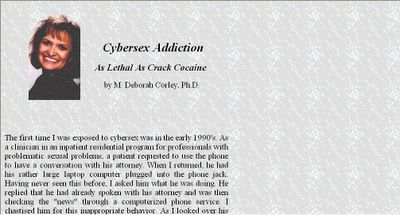
Using the Kalichman Sexual Compulsivity Scale (1994), the research indicated that 84 percent of the respondents did not meet criteria for cybersex compulsivity. However, 33 percent showed the early stages of cybersex compulsive use and another 6 percent suggested cybersex addiction. If you take this into account with conservatively 158 million Internet users, that's a lot of folks with a problem.
Recreational users access online sexual material out of curiosity or for entertainment but they do not report difficulty stopping or that it has caused any problems. The at-risk users have had no previous sexual addiction problems, but use the cyber activity as an escape. This group is more likely to be depressed and stress reactive. If they continue this behavior, it will most likely progress to compulsive or addictive use. The addictive or compulsive user often has a history of problematic sexual behavior and uses the Internet to act out in the same way a drug addict uses drugs. This user is unable to tolerate emotional distress, and the welcomed isolation and anonymity of the Internet allows for use to progress beyond what is controllable.
In her research, Schneider (2000) reported differences between male and female users. Males objectified the "partner" more often and preferred viewing pornography or voyeuristic behaviors. Females sought romantic relationships via chat rooms. Men were more likely to be anonymous in their interactions, while women were more exhibitionistic with their talking and video streaming. About 80 percent of the women progressed from online pursuits to real-life sex as compared to only 30 percent of the men.
By Nilsen RHEVI at http://nilsen.home.ro
Aucun commentaire:
Enregistrer un commentaire